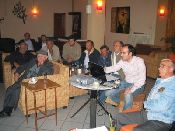|
Stakeholder Workshop 2: Synthesis report |
 |
|
This report
- provides results from the single steps of the assessment and decision-making process in the study sites;
- identifies strengths and weaknesses of the methodology as well as challenges in its use.
In general, the feedback on the workshop methodology was positive. However, in some sites it was found too difficult to use it when working with participants with a low educational level.
The methodology was found challenging because of the following.
- Adaptation of options from other contexts: working with external options (from WOCAT DB) requires a good understanding of SLM principles and appropriate experience to properly adapt them to the local context.
- Decision support software: moderators must be clear about the potential and limitations of the Facilitator software to avoid false expectations and mistrust.
- Complexity of methodology: the consecutive steps which build on each other and the complexity of the methodology render its implementation challenging for all involved partners.
- Integration of the three components of the stakeholder workshop methodology: to make sure that the parts fit together some continuity is required from Workshop 1 to Workshop 2 regarding: composition of stakeholders that participate; SLM objectives focused on; selected options.
| Strengths of the methodology |
Weaknesses of the methodology
|
- Well structured. Methodology leads step-by-step through a clearly structured decision-making process.
- Facilitator software. Runs complex calculations which would be difficult to do manually; graphs allow visual comparison.
- Mutual understanding. Negotiation requires that different points of view are listened to and discussed. This encourages changes in perspectives and mind sets, and enhances respecting and understanding different stakeholders’ perceptions.
- Commitment of stakeholders. Seeking commitment for implementation process was possible due to: exchange of ideas and experience; trust; interaction and collaboration among different stakeholder groups. This process started in Workshop 1 and continued to Workshop 2:
|
- Rigidity of the procedure. Steps cannot be skipped without hampering the result.
- Software bugs. Facilitator is not as easy-to-use as expected; it still has bugs.
- Lack of embedding in a broader SLM strategy. Short workshop duration impedes in-depth discussion to define a broader SLM strategy, which would allow to embed the selected technologies in a broader context and perspective, taking into account relevant socio-economic, institutional and policy issues.
- Limited knowledge exchange between study sites. Conservative attitudes towards previously unknown technologies and the fact that options from other contexts only enter the process in the Workshop 2 (after local options have been discussed a lot in the Workshop 1) bear the risk that these ‘new’ options are ‘overlooked’ and not considered enough.
|
|





